| This article needs additional citations for verification. Please help improve this article by adding citations to reliable sources. Unsourced material may be challenged and removed. Find sources: "Historical coins and banknotes of Poland" – news · newspapers · books · scholar · JSTOR (January 2021) (Learn how and when to remove this message) |




 The Polish–Lithuanian Commonwealth first issued złotych banknotes in 1794 under the authority of Tadeusz Kościuszko. The 5, 10, 25, 50, and 100 złotych are depicted above. A 500 and 1,000 złotych were issued but are very rare.
The Polish–Lithuanian Commonwealth first issued złotych banknotes in 1794 under the authority of Tadeusz Kościuszko. The 5, 10, 25, 50, and 100 złotych are depicted above. A 500 and 1,000 złotych were issued but are very rare.
This is a list of historical coins and banknotes of Poland.
Before the 20th century
| Unit (ZŁ) | Obverse | Reverse |
|---|---|---|
| Coins (Kingdom of Poland) | ||
| Banknotes (Polish-Lithuanian Commonwealth) | ||
| 4 zł |  |
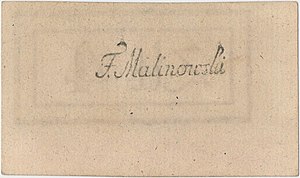
|
| Banknotes (Duchy of Warsaw) | ||
| Coins (1815-1850) | ||
| 2 zł | 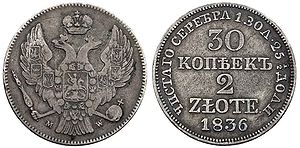
| |
| 5 zł | 
| |
| Banknotes (1850-1917) | ||
20th-century and interwar
| Unit (ZŁ) | Obverse | Reverse |
|---|---|---|
| Banknotes (1917-1924) | ||
| 1⁄2 mark |  |

|
| 10 marks |  |
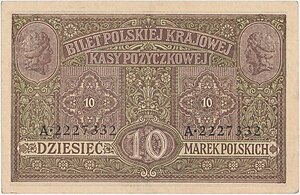
|
| 50 marks | 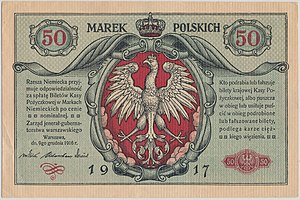 |

|
| 100 marks |  |

|
| Banknotes (1924-1939) | ||
| 10 gr |  |

|
| 2 zł (1936) |  |

|
| 5 zł (1930) |  |

|
| 10 zł (1929) |  |

|
| 20 zł (1929) |  |

|
| 20 zł (1931) |  |

|
| 20 zł (1936) |  |

|
| 50 zł (1929) |  |
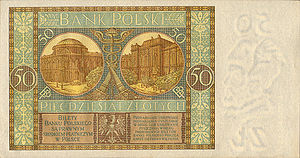
|
| 50 zł (1936) |  |

|
| 100 zł (1934) |  |

|
| Banknotes (1939-1944) | ||
| 1 zł (1940) |  |

|
| 1 zł (1941) | 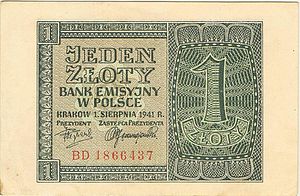 |

|
| 2 zł (1941) |  |

|
| 5 zł (1940) | 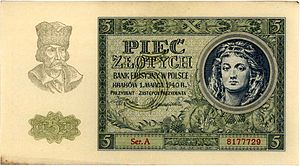 |
|
| 5 zł (1941) |  |

|
| 10 zł (1940) |  |

|
| 20 zł (1940) |  |
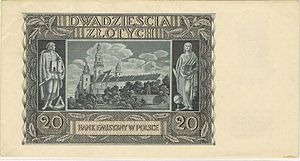
|
| 50 zł (1940) |  |

|
| 50 zł (1941) |  |

|
| 100 zł (1940) |  |

|
| 100 zł (1941) |  |

|
| 500 zł (1940) |  |

|
Coins
1924 - See Dziennik Ustaw 1924-045
Post-WWII
| Image | Unit (ZŁ) | Obverse | Reverse |
|---|---|---|---|
| Banknotes (1945-1950) | |||
| 20 zł |  |

| |
| 100 zł |  |

| |
| 500 zł |  |

| |
| 1000 zł |  |

| |
1950-currency reform
Series of 1948
The banknotes of the series of 1948 were designed by Polish painter and decorative artist Wacław Borowski. The introduction of these notes was part of the currency reform of 1950, so the banknotes had to be printed quickly and in secrecy; so printing works in Poland (PWPW), Czechoslovakia (STC), Hungary (Pénzjegynyomda), Sweden (Riksbankens Sedeltryckeri), and Canada (British American Bank Note Company Ltd.) were involved.
| Series of 1948 | |||||||||
|---|---|---|---|---|---|---|---|---|---|
| Image | Value | Dimensions | Description | Date of | |||||
| Obverse | Reverse | Obverse | Reverse | first printing | issue | withdrawal | lapse | ||
| 2 zł | 120 mm × 58 mm | Face value | The design of the (then) future NBP building at Warsaw Insurgents Square in Warsaw | 1 July 1948 | 30 October 1950 | 1 January 1960 | 30 June 1960 | ||
| 5 zł | 142 mm × 67 mm | Face value | Farmer plowing a field with a tractor | ||||||

|

|
10 zł | 148 mm × 70 mm | Portrait of a peasant (inspired by Mateusz Jóźwiak, the creator of cast printing matrices at PWPW) | Peasants loading sheaves to a ladder wagon. | 31 December 1965 | 30 June 1966 | ||

|

|
20 zł | 160 mm × 76 mm | Portrait of a woman in kerchief (nicknamed "Anielka"; the portrait was supposedly inspired by Helena Michalik (née Bujak), who was a friend of Wacław Borowski) | Kraków Cloth Hall | 30 June 1977 | 31 December 1977 | ||

|

|
50 zł | 164 mm × 78 mm | Portrait of a fisherman | Port of Gdynia | 30 June 1978 | 31 December 1978 | ||

|

|
100 zł | 172 mm × 82 mm | Portrait of a worker (a so-called "Pstrowski"; portrait inspired by Bronisław Tomaszewski, who was a driver at PWPW) | View of a factory with smoking chimneys (probably Łódź) | 30 June 1977 | 31 December 1977 | ||

|

|
500 zł | 178 mm × 85 mm | Portrait of a miner in helmet | Underground mining scene | 31 December 1977 | 30 June 1978 | ||
| These images are to scale at 0.7 pixel per millimetre. For table standards, see the banknote specification table. | |||||||||
Series of 1974
The National Bank of Poland began to introduce banknotes with the faces of "Great Poles" and the series was first introduced on 16 December 1974 with the 500 Zloty note. As economical situations worsened, by the 1980s higher and higher denonimations worsened and in 1989, the 20000 was adopted which was equvialent to half of a wage of that time(65,000 Zloty). By the end of 1989, a commemorative note was released into circulation, the 200,000 Zloty banknote which is rather a numismatical product(which still has a huge price tag even today) than an actual banknote meant for everyday payments/transactions. In 1990, as wages were regulated to the actual value of the currency, new higher denonimation notes were released such as the 500,000 Zloty note which was worth 50 Dollars and then it was devalued to 30 dollars when a new exchange rate was finalized to prevent hyperinflation. At the end of 1993, new reworked editions of banknotes(50.000,100.000,500.000,1.000.000 and 2.000.000 Zloty) were released which also erased the old Polish People's Republic name from the 50.000 and 100.000 Zloty banknotes in circulation. In 1994 they stopped printing old Zloty notes to later establish the Fourth Zloty by 1st January 1995. All of the banknotes together were withdrawn on 31st December 1996 and were no longer exchanged by 2010.
| 1974 Series | |||||||
|---|---|---|---|---|---|---|---|
| Image | Value | Dimensions | Colour | Obverse | Reverse | Printed | Withdrawn |
 
|
10 zł | 139 x 63 mm | Bluish green | Józef Bem | Indication of value | 1982 | 31 December 1996 |
| 20 zł | Multicoloured | Romuald Traugutt | Indication of value | 1982 | |||
| 50 zł | Green | Karol Świerczewski | Grunwald Cross Medal | 1975,1979,1982, 1986,1988 | |||
| 100 zł | Red | Ludwik Waryński | "Proletaryat" (19th century Polish socialist party) | 1975,1976, 1979,1982,1986,1988 | |||
| 200 zł | Violet | Jarosław Dąbrowski | Monument to the Dead (of the Paris Commune) by Paul Moreau-Vauthier in the Père Lachaise Cemetery | 1976, 1979,1986,1988 | |||
| 500 zł | Brown | Tadeusz Kościuszko | "Żywią i Bronią" (They feed and defend), flag of Polish soldiers in Kraków during the Kościuszko Uprising | 1974,1976,1979,1982 | |||
| 1000 zł | Blue | Nicolaus Copernicus | Heliocentric Solar System | 1975,1979,1982 | |||
| 2000 zł | Brown | Mieszko I | Bolesław I the Brave | 1977,1979,1982 | |||
| 5000 zł | Green | Frédéric Chopin | Polonaise notes | 1982,1986, 1988 | |||
| 10 000 zł | Green and violet | Stanisław Wyspiański | Kraków | 1987,1988 | |||
| 20 000 zł | Orange | Maria Skłodowska-Curie | Nuclear reactor "Ewa" near Warsaw | 1989 | |||
| 50 000 zł | Brown | Stanisław Staszic | The Staszic Palace in Warsaw | 1989,1993 | |||
| 100 000 zł | Blue | Stanisław Moniuszko | Teatr Wielki, Warsaw | 1990,1993 | |||
| 200 000 zł | Brown | Coat of arms | Warsaw | 1989 | |||
| 500 000 zł | Blue and brown | Henryk Sienkiewicz | "Trilogy" | 1990,1993 | |||
| 1 000 000 zł | Light brown | Władysław Reymont | Country landscape | 1991,1993 | |||
| 2 000 000 zł | Multicoloured | Ignacy Jan Paderewski | The 1919 Coat of arms of Poland | 1992,1993 | |||
| These images are to scale at 0.7 pixels per millimeter, a standard for world banknotes. | |||||||
A lot of these banknotes that circulated from 1974 to 1988 were printed in several years.
See also
References
- The 1950 currency reform, i.e. let's take people's money
- Anielka - a mysterious worker from a banknote.
- Girl with a banknote